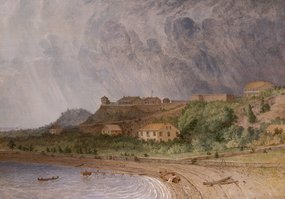Fort Mackinac
|
|
Fort Mackinac, later known Fort Holmes, was a military outpost that existed from the late 18th century to the late 19th century on Mackinac Island in the U.S. state of Michigan. Built by the British during the American Revolutionary War to control the strategic Straits of Mackinac between Lake Michigan and Lake Huron (and by extension the fur trade on the Great Lakes), it was not relinquished by the British until fifteen years after American independence. It later became the scene of two strategic battles for control of the Great Lakes during the War of 1812. During most of the 19th century, it served as an outpost of the United States Army. Closed in 1895, the fort is now a museum on the grounds of Mackinac Island State Park and has been designated a National Historic Landmark.
| Contents |
History
Revolutionary War
Before 1763 the French had controlled the Straits of Mackinac by the similarly named Fort Michilimackinac on the mainland on the south shore of the passage. After the 1763 Treaty of Paris, the British occupied the French fort but deemed the wooden structure too difficult to defend. During 1780-1781, they constructed a new limestone fort on the limestone bluffs of Mackinac Island and held the outpost throughout the war. After the 1783 Treaty of Paris, the British did not relinquish the fort until 1796.
War of 1812
At the start of the War of 1812, the fort was manned by a small U.S. garrison of approximately 60 men under the command of Lt. Porter Hanks. British General Isaac Brock, having anticipated the start of war, sent a canoe party 1200 miles (1900 km) to confirm that a state of war existed. The American commander Hanks, however, received no notification of the start of the conflict. On the morning of July 17, 1812, a British and Native American combined force of seventy war canoes and ten bateaux landed on the north end of the island, 2 mi (3.2 km) away from the fort. The British quietly removed the village inhabitants from their home and trained two cannon at the fort. The American commander, taken completely by surprise, realized he was badly outnumbered, and fearing a massacre by the Native Americans on the British side, accepted the British offer of surrender without a fight. The American force was taken prisoner and the island inhabitants were made to swear an oath of allegiance as subjects of the United Kingdom. After capturing the island, the British, under the command of Colonel Robert McDouall of the Royal Newfoundland Regiment, also built a stockade and blockhouse on the island's highest point, renaming it as Fort George.
In the July 1814 Americans attempted to retake the island as part of a larger campaign designed by Colonel George Croghan and his superior General William Henry Harrison to capture control of the Great Lakes and sever the fur trade alliance between the British and the tribes of the region. The two-pronged campaign included an assault on Prairie du Chien on the Mississippi River.
On July 26, a squadron of five U.S. ships arrived off the Mackinac Island carrying a landing force of 700 soldiers under the command of Croghan. To his dismay, Croghan discovered that the new British blockhouse stood too high for the naval guns to reach, forcing an unprotected assault on the fort's wall. The Americans shelled the fort for two days, with most of the shells falling harmlessly in vegetable gardens around the fort.
A dense fog forced the Americans back from the island for a week before returning. Upon their return the Americans, led by Major Andrew Holmes, assaulted the north end of the island, near the location of the 1812 British assault. The Americans worked their way to the fort through dense woods which were protected by Native American allies of the British, finally emerging into a clearing below the fort.
McDouall, in the meantime, had placed a small force bearing muskets, rifles, and two field guns, behind low breastworks at the opposite end of the clearing. When the Americans emerged from the woods into the clearing, they were easy targets for the British guns. Thirteen Americans, including Major Holmes and two other officers, were killed, and 51 were wounded. Because of the heavy losses, Croghan was forced to order his men to retreat back through the woods to the beach. The Americans rowed back to their ships, leaving the fort in the hands of the British through the end of the war.
Later Years
The American reoccuppied the fort in July 1815 following the Treaty of Ghent. They renamed the expanded fort as Fort Holmes, in honor of Maj. Holmes, who had been killed in the 1814 attack. During the mid 19th century, the fort became an important staging area for exploration of the northern Michigan Territory, including the 1832 expedition under the command of Lewis Cass to explore the headwaters of the Mississippi River. The post of Indian agent at the fort was held for a time in the 1830s by Henry Schoolcraft, who conducted pioneering studies of the Native American languages and culture of the region.
An 1872 oil painting of the fort by Seth Eastman is part of the collection of the United States Senate. From 1875 to 1895, the fort and much of the island were part of Mackinac National Park, the second national park in the United States after Yellowstone National Park. After its closure in 1895, it became part of Mackinac Island State Park, the first state park in Michigan. The current museum includes 14 historic buildings.
External links
- War of 1812: The British Capture Fort Mackinac (http://www.galafilm.com/1812/e/events/mackinac.html)
- Battle of Fort Mackinac: July 1814 (http://members.tripod.com/~war1812/batmac1814.html)
- Mackinac Island State Park (http://www.mackinacparks.com/statepark/)
- Michigan Historical Markers: Historic Fort Mackinac (http://www.michmarkers.com/startup.asp?startpage=S0189.htm)
- U.S. Senate: 1872 Seth Eastman oil painting (http://www.senate.gov/artandhistory/art/artifact/Painting_33_00014.htm)de:Fort Mackinac

